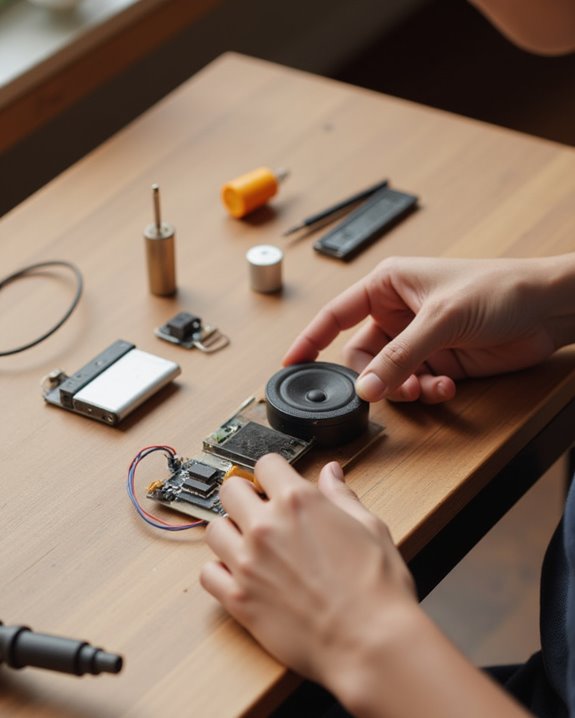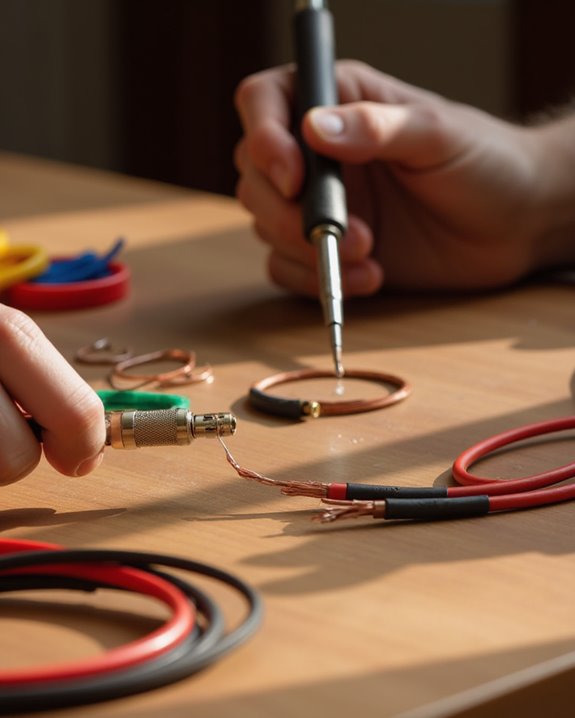The top speaker cables for home cinema systems include AudioQuest Rocket 22 for premium performance, Chord Company C-Screen for budget-conscious setups, oxygen-free copper cables for humidity resistance, 12-gauge wires for powerful bass response, and silver-coated conductors for superior clarity. For runs under 50 feet, 16-gauge cables suffice with 8-ohm speakers, while longer distances require 14-gauge or thicker wires. Proper installation with matched polarity and secure connections guarantees these cables deliver their full sonic potential in your theater environment.
Key Takeaways
- AudioQuest Rocket 22 delivers exceptional clarity and dynamic expression for high-end home cinema setups despite its premium price point.
- Chord Company C-Screen offers excellent value at £45-£49 while providing adequate performance for modest home theater systems.
- For longer cable runs exceeding 50 feet, 12 or 14-gauge oxygen-free copper cables maintain audio dynamics and prevent signal degradation.
- Bi-wire configurations with separate wire pairs for high and low frequencies reduce interference for greater clarity in surround sound systems.
- Silver-coated copper conductor cables provide superior conductivity and clearer sound reproduction across all channels in a home cinema setup.
Understanding Speaker Cable Gauge and Its Impact on Home Cinema Audio
Why do seemingly simple speaker cables play such an essential role in home cinema performance? The gauge (thickness) of speaker wire fundamentally determines how effectively audio signals travel from amplifiers to speakers, directly influencing system sound quality. Lower American Wire Gauge (AWG) numbers indicate thicker cables with reduced resistance, essential for maintaining signal integrity across longer distances.
For standard 8-ohm speaker setups, 16-gauge copper wire sufficiently handles runs up to 50 feet, while distances beyond this threshold benefit from 14-gauge or thicker cables to preserve audio dynamics. High-power systems with low-impedance speakers (4-6 ohms) perform ideally with 12-gauge wire, ensuring accurate bass reproduction. Additionally, Oxygen-free copper speaker cables resist degradation over time, helping your system sound better through consistent signal transmission, particularly in humidity-prone environments where standard copper might oxidize.
Premium vs. Budget Options: Finding the Right Cable for Your System
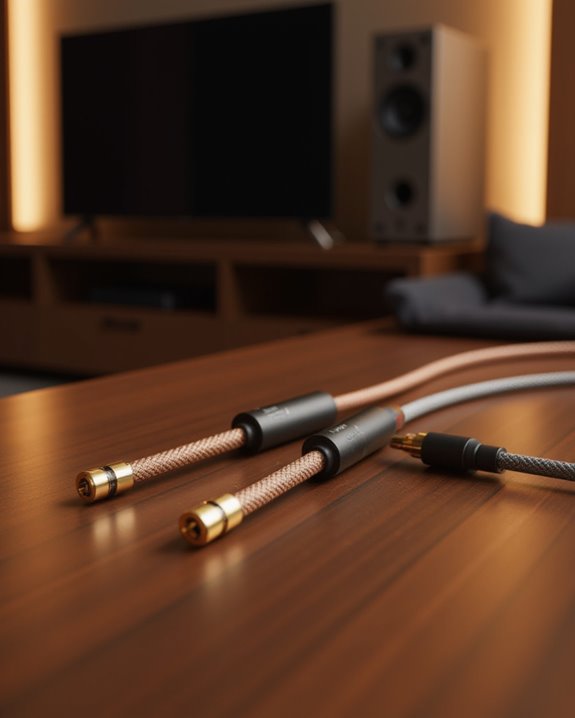
How greatly does cable quality impact the overall performance of a home cinema system? The difference between high-end speaker cables and budget options can make your system sound noticeably better, particularly in systems where other components are already optimized. Experts suggest allocating approximately 10% of your total system cost to cabling, with premium options like the AudioQuest Rocket 22 (£489) offering superior transparency and dynamic expression compared to budget alternatives.
The Best speaker cable choice depends on your specific setup requirements. While budget cables like Chord Company C-Screen (£45-£49) provide adequate performance for modest hi-fi setups, higher quality cables utilizing copper or silver conductors make a difference in longer runs and high-power systems. Audiophile speaker enthusiasts note that premium speaker wires demonstrate measurably lower resistance and capacitance, reducing signal loss in demanding home cinema applications. For systems with high power demands, such as the Pyle systems featuring 1000W output, investing in premium cables ensures minimal loss in audio fidelity.
Bi-Wire Configurations and When They Enhance Performance
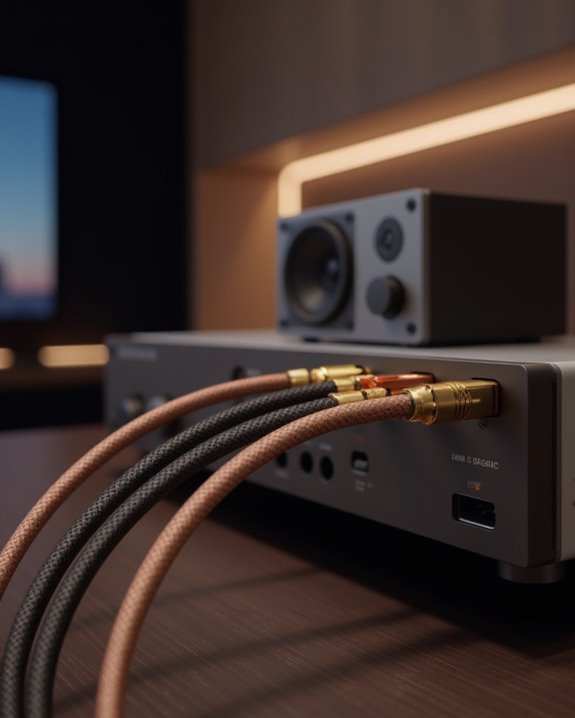
Beyond selecting the right quality level for your system, another configuration option merits consideration for discerning home cinema enthusiasts. Bi-wire configurations divide the audio signal between separate wire pairs for high and low frequencies, utilizing specialized speaker cables often featuring dual conductor sets like the AudioQuest Rocket 11.
This arrangement requires speakers with separate binding posts for treble and bass drivers, allowing users to connect speaker terminals with banana plugs, spade connectors, or bare wire according to preference. The separation reduces electrical interference between frequency ranges, potentially delivering greater clarity and dynamic expression when properly implemented. For best results, experts recommend using bi-wire setups with 16-gauge or thicker cables for distances up to 50 feet, ensuring minimal resistance and maintained signal integrity throughout the system’s signal path.
Cable Material Composition: Copper, Silver, and Hybrid Conductors

The material composition of speaker cables plays a crucial role in determining their performance capabilities, with copper, silver, and hybrid conductors each offering distinct sonic characteristics to home cinema enthusiasts. Oxygen-free copper conductors, found in models like Chord Company C-Screen and AudioQuest Rocket 11, resist oxidation, preserving conductivity and signal integrity over time. For those seeking enhanced performance, silver-coated copper strands combine durability with superior conductivity, delivering clearer, more transparent sound reproduction. Pure silver conductors, with up to 6% higher conductivity than copper, represent the premium option for discerning listeners, providing improved dynamics and vibrancy. Hybrid conductors, such as those in the Chord Company RumourX, merge these benefits to minimize signal loss, resulting in a more refined experience with tauter bass and detailed high frequencies.
Installation Best Practices for Optimal Sound Quality
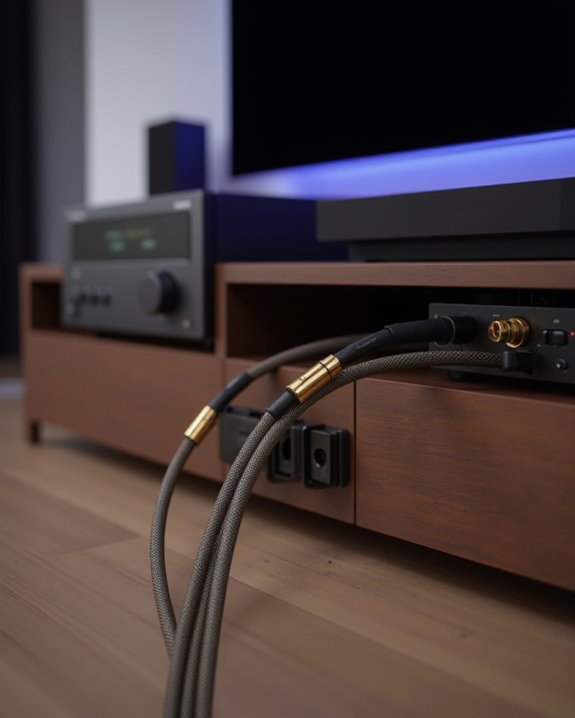
Proper installation techniques represent the foundation of exceptional home cinema audio, ensuring that even the highest quality speaker cables can deliver their full potential without compromise. When connecting components, maintain consistent polarity by matching the positive (red) terminal to the positive input and negative (black) terminal to the negative input on both amplifier and right speaker. Choose the right gauge—16-gauge wire provides a wide range of benefits for runs up to 50 feet with 8-ohm speakers. Measure precisely using string, adding 10-20% extra length to prevent tension. For in-wall installations, select UL-rated CL2 or CL3 cables to meet safety codes. Strip exactly 3/8-inch of insulation, twisting copper strands tightly to make connecting secure, unlike RCA cables which use different connectors entirely. To maximize compatibility with advanced audio features, consider systems that incorporate Dolby Atmos for an enhanced immersive experience.
Frequently Asked Questions
What Is the Best Speaker Wire for Home Theater?
Speaker wire selection depends on length impact, with RumourX or Rocket 11 preferred for their durability testing results. Quality wires feature eco materials, allow custom cuts, and offer various color choices for easy installation and discreet storage methods.
What Cables Do I Need for a Home Theater System?
Over 85% of home theater performance depends on proper cabling. Essential connections include HDMI options for video formats, optical types for digital audio sources, power connectors, RCA alternatives, component choices, and dedicated subwoofer connections.
What Cable Gives the Best Sound Quality?
Signal purity and audio clarity depend on multiple factors. Oxygen Free Copper conductors with shielded wiring minimize noise reduction while preserving frequency response. Material impact and impedance effects greatly influence the intimate soundscape audiophiles desire from their connections.
Which Is Better, 12 Gauge or 16 Gauge Speaker Wire?
Like choosing the right conductor for an orchestra, 12-gauge wire offers lower resistance levels for distances over 50 feet, while 16-gauge provides better flexibility, easier installation, and cost savings for shorter runs under 50 feet.


